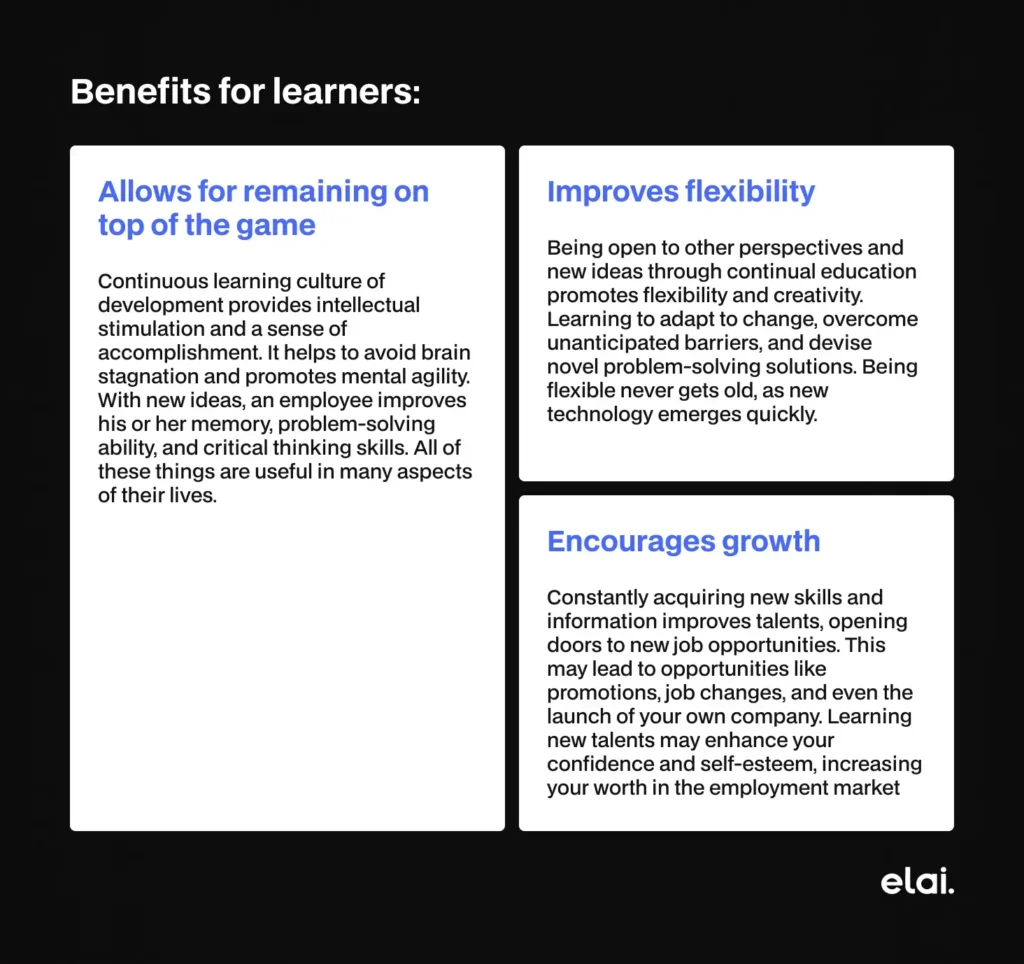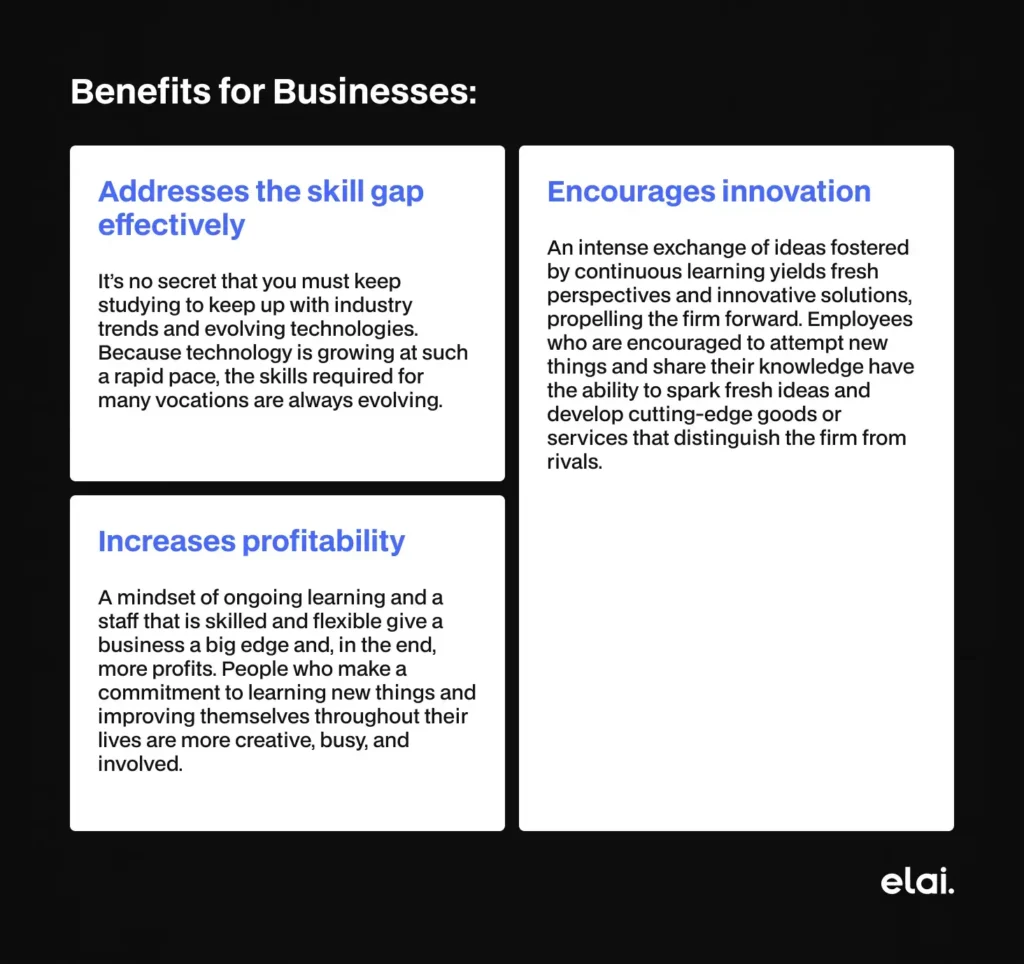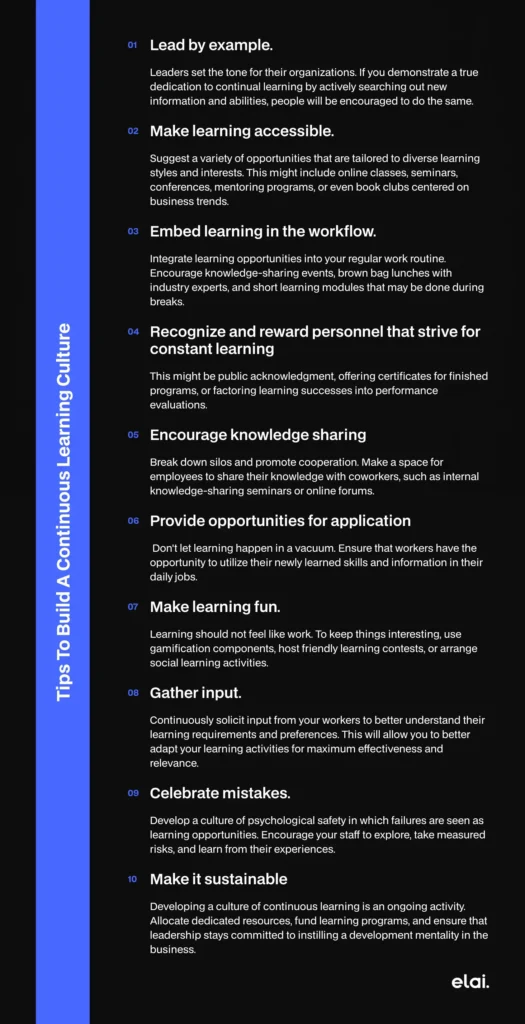Imagine working in an environment that values inquiry, encourages growth, and fosters the continuous development of new talents. This is not a pipe dream; for companies that foster a continuous learning culture, this is the actual world. You might ask yourself: “What is a culture of continuous learning?” To put it simply, it’s a setting where education is welcomed and integrated into the daily grind. It extends beyond required training courses or random seminars. It’s a common perspective that learning is a continuous process that’s necessary for both individual and corporate development.
This dedication to lifelong learning goes beyond established hierarchies. Leaders set an example for others by being curious and open to trying new things. They actively look for chances to grow with their staff, creating a psychologically secure environment where errors are accepted as necessary learning experiences. All employees have the authority to take responsibility for their own professional growth. They are urged to look for fresh problems, experiment with various strategies, and impart what they have learned to their peers. This cooperative attitude creates a sense of community in which information is openly shared rather than kept to oneself. Open lines of communication, knowledge-sharing forums, and mentoring programs become standard practices, building a collective pool of experience that is advantageous to all members of the business.
Why the culture of continuous learning is important
In the 21st century, companies must prioritize developing a continuous learning culture. The ever-changing expectations of customers, globalization, and technological breakthroughs are transforming the fundamental essence of employment itself. Companies need staff that can adapt, be inventive, and negotiate this changing environment if they want to stay ahead of the curve. This is what Vitalii Romanchenko is fostering as CEO of Elai.io.
Here are some reasons why fostering a culture of continuous learning is critical for corporate success. It stimulates inventiveness, to start. A creative workplace culture is fostered by encouraging staff members to experiment with new concepts, try out novel strategies, and share knowledge with one another. This helps firms stay ahead of the competition by creating a pipeline of new ideas and creative solutions. Second, the skills gap is closed by ongoing learning. Technology is changing at an unstoppable rate, and many professions demand abilities that are continually changing. By offering chances for continuous education and training, companies guarantee that their employees have the abilities needed to continue being efficient and productive.
A mindset of always learning also makes employees more interested and driven. People are more likely to be interested in their work if they think their needs are being met and their potential is being noticed. Giving employees the chance to learn shows that the business values its growth, loyalty and commitment. Higher employee satisfaction, lower attrition, and, eventually, a more robust and cohesive team are the results. Lastly, a future-proof organization is fostered by constant learning. The capacity to adapt and learn is essential in a society where change is continuous. Organizations may equip themselves with the agility and resilience required to manage unanticipated difficulties and capture new opportunities by cultivating a culture of continuous learning. This guarantees success and long-term sustainability in a dynamic business environment.
The benefits of a continuous learning culture
Continuous learning helps both people and companies. Let’s look further into the numerous benefits it offers.
Benefits for learners:
- Encourages growth: Constantly acquiring new skills and information improves talents, opening doors to new job opportunities. This may lead to opportunities like promotions, job changes, and even the launch of your own company. Learning new talents may enhance your confidence and self-esteem, increasing your worth in the employment market.
- Improves flexibility: Being open to other perspectives and new ideas through continual education promotes flexibility and creativity. Learning to adapt to change, overcome unanticipated barriers, and devise novel problem-solving solutions. Being flexible never gets old, as new technology emerges quickly.
- Allows for remaining on top of the game: Continuous learning culture of development provides intellectual stimulation and a sense of accomplishment. It helps to avoid brain stagnation and promotes mental agility. With new ideas, an employee improves his or her memory, problem-solving ability, and critical thinking skills. All of these things are useful in many aspects of their lives.

Benefits for Businesses:
- Encourages innovation: An intense exchange of ideas fostered by continuous learning yields fresh perspectives and innovative solutions, propelling the firm forward. Employees who are encouraged to attempt new things and share their knowledge have the ability to spark fresh ideas and develop cutting-edge goods or services that distinguish the firm from rivals. This approach fosters an environment of creativity and problem-solving thinking, resulting in a more lively and profitable firm.
- Addresses the skill gap effectively: It’s no secret that you must keep studying to keep up with industry trends and evolving technologies. Because technology is growing at such a rapid pace, the skills required for many vocations are always evolving. Companies can close the skills gap and keep a useful and productive workforce by investing in staff development.
- Increases profitability: A mindset of ongoing learning and a staff that is skilled and flexible give a business a big edge and, in the end, more profits. People who make a commitment to learning new things and improving themselves throughout their lives are more creative, busy, and involved. This makes the job better, makes clients happier, and makes the business more competitive in the market. Supporting a mindset of continuous learning may also lead to less staff churn, which saves the company time and money on the costs of hiring new people and teaching them.

Tips On How To Create A Continuous Learning Culture
A culture of continuous learning does not happen overnight, but with effort and the correct techniques, you can create an atmosphere in which growth and development are emphasized. Here are some important recommendations to get you started:
- Lead by example. Leaders set the tone for their organizations. If you demonstrate a true dedication to continual learning by actively searching out new information and abilities, people will be encouraged to do the same.
- Make learning accessible. Suggest a variety of opportunities that are tailored to diverse learning styles and interests. This might include online classes, seminars, conferences, mentoring programs, or even book clubs centered on business trends.
- Embed learning in the workflow. Integrate learning opportunities into your regular work routine. Encourage knowledge-sharing events, brown bag lunches with industry experts, and short learning modules that may be done during breaks.
- Recognize and reward personnel that strive for constant learning. This might be public acknowledgment, offering certificates for finished programs, or factoring learning successes into performance evaluations.
- Encourage knowledge sharing. Break down silos and promote cooperation. Make a space for employees to share their knowledge with coworkers, such as internal knowledge-sharing seminars or online forums.
- Provide opportunities for application. Don’t let learning happen in a vacuum. Ensure that workers have the opportunity to utilize their newly learned skills and information in their daily jobs.
- Make learning fun. Learning should not feel like work. To keep things interesting, use gamification components, host friendly learning contests, or arrange social learning activities.
- Gather input. Continuously solicit input from your workers to better understand their learning requirements and preferences. This will allow you to better adapt your learning activities for maximum effectiveness and relevance.
- Celebrate mistakes. Develop a culture of psychological safety in which failures are seen as learning opportunities. Encourage your staff to explore, take measured risks, and learn from their experiences.
- Make it sustainable. Developing a culture of continuous learning is an ongoing activity. Allocate dedicated resources, fund learning programs, and ensure that leadership stays committed to instilling a development mentality in the business.

Examples of continuous learning
Imagine a society where regular people, via citizen science projects, can bring forth revolutionary scientific breakthroughs. The term “citizen science” refers to initiatives that bring together non-specialists and trained researchers in order to conduct scientific studies in the actual world. Data collection for these types of initiatives often makes use of online classifications, observations, or mobile applications. One such citizen science initiative is Galaxy Zoo, which uses telescope images to recruit volunteers for the task of galaxy classification. While learning about galaxies and categorization procedures, individuals may actively contribute to our knowledge of the cosmos. This also helps astronomers classify massive volumes of data.
Microlearning and mobile apps have made long training classes useless. These applications provide concise, interesting lectures on various subjects, including language acquisition and professional growth. In this hypothetical scenario, a doctor is waiting for their next appointment as a busy marketer learns about a new social media advertising platform on their morning commute. Microlearning applications provide effective and hassle-free continual learning.
In traditional mentoring programs, more seasoned professionals help guide and build the careers of others with less experience. However, how about we switch things around? A more interactive and engaging learning environment may be created via reverse mentoring programs, which pair more seasoned workers with their younger counterparts. In contrast to the senior staff’s extensive knowledge of the sector and ability to think strategically, the younger staff members provide new ideas, digital fluency, and awareness of current trends. More collaboration and creativity in the workplace are outcomes of this mutually beneficial learning exchange.
How to use AI to build continuous learning
A powerful culture of continuous learning may be established by using the following AI technologies:
Personalized Learning with AI Recommendations
AI can assess a learner’s aptitude, learning style, and professional aspirations to create individualized learning plans, suggesting books, websites, and videos to help them succeed. Such AI systems that analyze a new hire’s job description and recommend training modules can easily help them improve their skills. Focused learning and individual engagement are both ensured by this data-driven strategy.
Dynamic, Difficulty-Based Microlearning
AI-powered Microlearning: Artificial intelligence may be used to improve microlearning, which are little learning modules, and make them more adaptable. On the basis of the learner’s progress, these modules modify the level of difficulty and the information that is presented. For instance, an AI video generator may adjust the number of practice exercises provided or the level of detail in a video explanation depending on how well the learner understands the idea. So, students aren’t stifled by too much information or too little, and they may reach their full academic potential.
AI-Powered Live Training and Feedback
AI-enhanced Coaching and Feedback: AI has the potential to play the role of a virtual coach, offering timely and tailored comments. A student’s results in simulations, quizzes, or coding assignments may help AI instructors identify problem areas and provide specific comments or steps to fix them. Imagine a sales presentation video being reviewed by an AI that then provides recommendations on content or delivery. This kind of immediate feedback keeps students engaged and aids in their retention of material.
Curating and Recommending Content with the Help of AI Assistants
Intelligent Content Suggestions: The sheer volume of information available online may be overwhelming. With the help of the learner’s interests, objectives, and previous actions, AI may play the role of a curator and suggest appropriate material. Artificial intelligence can evaluate a student’s performance in online video classes and provide recommendations for related or supplemental video lectures to help them learn more. In addition to saving time, this method guarantees that students are concentrating on relevant, high-quality materials.
Creating Online Communities
Learners may interact, exchange information, and debate difficulties in online communities driven by AI. Artificial intelligence (AI) may analyze user interactions to suggest appropriate talks or pair learners with others who have comparable interests or domain knowledge. Picture this: an AI suggests that a student who has just finished a video course on social media marketing sign up for a forum where they can network with other experts in the subject. This promotes an atmosphere of mutual learning where people may inspire and support one another as they pursue lifelong education.
AI-Powered Video Creation
Videos for Dynamic Learning: Technologies for artificial intelligence video creation can make videos for specific learning needs. With generators like Elai.io you can personalize these videos to fit someone’s learning style, language preference, or focal area. An AI could, for an employee who does better with visuals than words, create a video that breaks down a difficult financial idea. This customization has the potential to greatly improve engagement and the ability to retain information.
Learning with Interactive Video: With the use of the AI video generator Elai.io, you can make video courses that learners may navigate at their own pace. Imagine a video course on leadership styles where students could pick and choose whatever types they wanted to learn about, like transformational leadership. The instructor would go into detail about that style using real-world examples. Learners are kept interested and may personalize their learning experience via this interaction.
By utilizing AI in these ways, companies can establish an interactive and tailored learning atmosphere that encourages ongoing education and grants people the means to realize their maximum capabilities.

